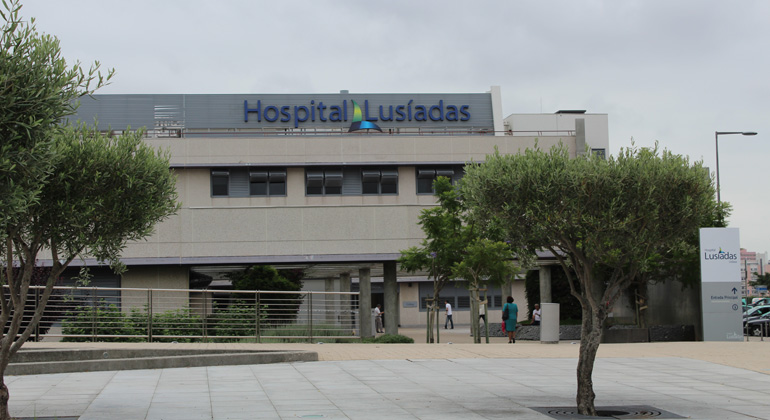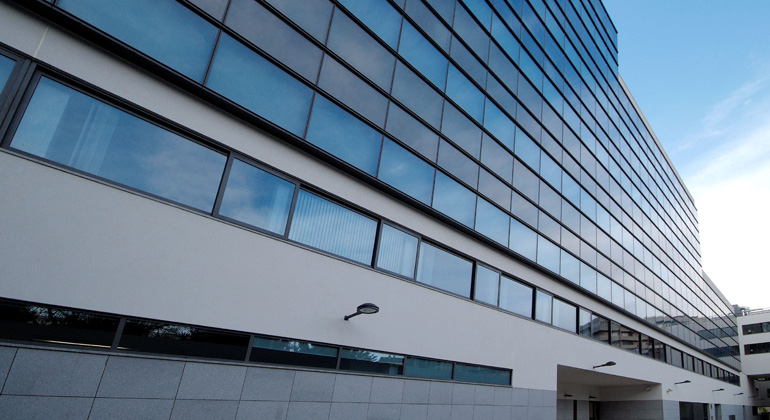Foraminectomy + Discectomy of Lumbar / Back Disc
A foraminotomy that removes a large amount of bone or other material may occasionally be described as a foraminectomy.
If you would like to learn more information about Orthopedic Surgery in Portugal, contact us through email, by calling +351 220 973 751, +351 211 379 718, +351 911 046 197, or by filling out our form. You can also contact us through our free call service to your right.
Foraminotomy is surgery that widens the opening in your back where nerve roots leave your spinal canal. You may have a narrowing of the nerve opening (foraminal stenosis).
Description
Foraminotomy takes pressure off of a nerve in your spinal column. This allows the spine to move more easily. Foraminotomy can be performed on any level of the spine.
You will be asleep and feel no pain (general anesthesia).
During surgery:
- You lie face down on the operating table. A cut (incision) is made in the middle of the back of your spine. The length of the incision depends on how much of your spinal column will be operated on.
- Skin, muscles, and ligaments are moved to the side. Your surgeon may use a surgical microscope to see inside your back.
- Some bone is cut or shaved away to open the nerve root opening (foramen). Any disk fragments are removed.
- Other bone may also be removed at the back of the vertebrae to make more room (laminotomy or laminectomy).
- The surgeon may do a spinal fusion to make sure your spinal column is stable after surgery.
- The muscles and other tissues are put back in place. The skin is sewn together.
Why the Procedure is Performed
A bundle of nerves (nerve root) leaves your spinal cord through openings in your spinal column. These openings are called the neural foramena. When the openings for the nerve root become narrow, it can put pressure on your nerve. This condition is called foraminal spinal stenosis.
This surgery may be considered if you have severe symptoms that interfere with your daily life. Symptoms include:
- Pain that may be felt in your thigh, calf, lower back, shoulder, arms or hands. The pain is often deep and steady
- Pain when doing certain activities or moving your body a certain way
- Numbness, tingling, and muscle weakness
- You will have an MRI to make sure foraminal stenosis is causing your symptoms.
You and your doctor can decide when you need to have surgery. Foraminal stenosis symptoms often become worse over time, but this may happen slowly.
Before the Procedure
Tell your doctor or nurse what medicines you are taking. This includes medicines, supplements, or herbs you bought without a prescription.
During the days before the surgery:
- Prepare your home for when you leave the hospital after surgery.
- If you are a smoker, you need to stop. Your recovery will be slower and possibly not as good if you continue to smoke. Ask your doctor for help.
- Two weeks before surgery, your doctor or nurse may ask you to stop taking medicines that make it harder for your blood to clot. These include aspirin, ibuprofen (Advil, Motrin), naproxen (Aleve, Naprosyn).
- If you have diabetes, heart disease, or other medical problems, your surgeon will ask you to see your regular doctor.
- Talk with your doctor if you have been drinking a lot of alcohol.
- Ask your doctor which medicines you should still take on the day of the surgery.
- Let your doctor know right away if you get a cold, flu, fever, herpes breakout, or other illnesses.
- You may want to visit a physical therapist to learn exercises to do before surgery and to practice using crutches.
On the day of the surgery:
- You will likely be asked not to drink or eat anything for 6 to 12 hours before the procedure.
- Take the medicines your doctor told you to take with a small sip of water.
- Bring your cane, walker, or wheelchair if you have one already. Also bring shoes with flat, nonskid soles.
- Your doctor or nurse will tell you when to arrive at the hospital. Be sure to arrive on time.
After the Procedure
You will likely wear a soft neck collar afterward if the surgery was on your neck. Most people are able to get out of bed and sit up within 2 hours after surgery. You will need to move your neck carefully.
You should be able to leave the hospital the day after the surgery. You should be able to drive within a week or two and resume light work after 4 weeks.
Outlook (Prognosis)
Foraminotomy for spinal foraminal stenosis will often provide full or some relief of symptoms.
Future spine problems are possible for all patients after spine surgery. If you had foraminotomy and spinal fusion, the spinal column above and below the fusion could have problems in the future. If you needed more than one kind of precedure in addition to foraminotomy (such as laminotomy, laminectomy, or spinal fusion), you may have more of a chance of future problems.
Alternative Names
Intervertebral foramina; Spine surgery - foraminotomy
Discectomy is surgery to remove all or part of a cushion that helps protect your spinal column. These cushions, called disks, separate your spinal bones (vertebrae).
Description
A surgeon may perform disk removal (Discectomy) in different ways.
- MicroDiscectomy: When you have a microDiscectomy, the surgeon does not need to do much surgery on the bones, joints, ligaments, or muscles of your spine.
- Discectomy in the lower part of your back (lumbar spine) may be part of a larger surgery that also includes a laminectomy, foraminotomy, or spinal fusion.
- Discectomy in your neck (cervical spine) is most often done along with laminectomy, foraminotomy, or fusion.
- MicroDiscectomy is done in a hospital or outpatient surgical center. You will be given spinal anesthesia or general anesthesia (asleep and pain-free).
The surgeon makes a small (1 to 1-1/2 inch) incision (cut) on your back and moves the back muscles away from the spine. The doctor uses a special microscope to see the problem disk or disks and nerves during surgery.
The surgeon finds the nerve root and moves it away. Then the surgeon removes the injured disk tissue and pieces. The surgeon puts the back muscles back in place, and closes the wound with stitches or staples.
The surgery takes about 1 to 2 hours.
Discectomy and laminotomy is done in the hospital, using general anesthesia (asleep and pain-free).
The surgeon makes a larger cut on your back over the spine. Muscles and tissue are moved to expose your spine.
A small part of the lamina bone (part of the vertebrae that surrounds the spinal column and nerves) is cut away. The opening may be as large as the ligament that runs along your spine. The surgeon cuts a small hole in the disk that is causing your symptoms and removes material from inside. Other fragments of the disk may also be removed.
Why the Procedure is Performed
When one of your disks herniates (moves out of place), the soft gel inside pushes through the wall of the disk. The disk may then place pressure on the spinal cord and nerves that are coming out of your spinal column.
Many of the symptoms caused by a herniated disk get better or go away over time without surgery. Most people with low back or neck pain, numbness, or even mild weakness are often first treated with anti-inflammatory medicines, physical therapy, and exercise. Only a few people with a herniated disk need surgery.
Your doctor may recommend a Discectomy if you have a herniated disk and:
- Leg pain or numbness that is very bad or is not going away, making it hard to do daily tasks
- Severe weakness in muscles of your lower leg or buttocks
- Pain that spreads into your buttocks or legs
- If you are having problems with your bowels or bladder, or the pain is so bad that strong pain drugs do not help, you will probably have surgery right away.
Before the Procedure
Always tell your doctor or nurse what drugs you are taking, even drugs or herbs you bought without a prescription.
During the days before the surgery:
- Prepare your home for when you come back from the hospital.
- If you are a smoker, you need to stop. Your recovery will be slower and possibly not as good if you continue to smoke. Ask your doctor for help.
- Two weeks before surgery, you may be asked to stop taking drugs that make it harder for your blood to clot. These include aspirin, ibuprofen (Advil, Motrin), naproxen (Aleve, Naprosyn), and other drugs like these.
- If you have diabetes, heart disease, or other medical problems, your surgeon will ask you to see your regular doctor.
- Talk with your doctor if you have been drinking a lot of alcohol.
- Ask your doctor which drugs you should still take on the day of the surgery.
- Always let your doctor know about any cold, flu, fever, herpes breakout, or other illnesses you may have.
- You may want to visit the physical therapist to learn some exercises to do before surgery and to practice using crutches.
On the day of the surgery:
- You will usually be asked not to drink or eat anything for 6 to 12 hours before the procedure.
- Take your drugs your doctor told you to take with a small sip of water.
- Bring your cane, walker, or wheelchair if you have one already. Also bring shoes with flat, nonskid soles.
- Your doctor or nurse will tell you when to arrive at the hospital.
After the Procedure
Your doctor or nurse will ask you to get up and walk around as soon as your anesthesia wears off. Most people go home the day of surgery. Do NOT drive yourself home.
Outlook (Prognosis)
Most people have pain relief and can move better after surgery. Numbness and tingling should get better or disappear. Your pain, numbness, or weakness may not get better or go away if your had nerve damage before surgery or if you have symptoms caused by other spinal conditions.
Further changes may occur in your spine over time and new symptoms may occur.
Talk with your doctor about how to prevent future back problems.
Alternative Names
Spinal microDiscectomy; Microdecompression; Laminotomy; Disk removal; Spine surgery - Discectomy


